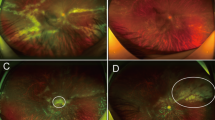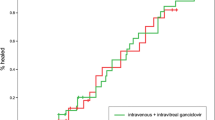Summary
Background: CMV retinitis is the most common opportunistic ocular infection and the main cause of blindness in AIDS patients with a T-helper cell count ≤ 50/μl. Cidofovir is a nucleotide analogue with a long half-life time after phosphorylation intracellularly. It is effective against CMV and can be given intravenously and intravitreally. The aim was to offer an alternative therapy for CMV retinitis to patients who could not receive standard treatment because of contraindications or refused it. The efficacy and tolerance of intravitreal injections of cidofovir should be evaluated.
Patients and methods: We treated 16 eyes of 12 patients. The total number of injections with 15 μg of cidofovir each was 49, with an average of 3 injections per eye. The duration of follow-up was 75–295 days (median 170 days). Probenecid was given concomitantly. Injections were repeated after 6–10 weeks. Secondary prophylaxis of CMV organ infection was done with oral ganciclovir.
Results: Within a few days all areas with active retinitis turned into scars following the first injection. Under consequent treatment no reactivation was observed. Four eyes developed a mild iritis with hypotony within a mean time of 12 days after injection. All responded rapidly to topical steroids. None had a persisting loss of vision. Two eyes developed cystoid macular edema (CME). Two patients stopped anti-CMV treatment (ganciclovir orally and injections), followed by a recurrence after an average of 64 days.
Conclusions: Intravitreal injection therapy with 15 μg cidofovir and concomitant oral probenecid is a valuable and safe alternative treatment for CMV retinitis in AIDS patients. Its main complication is iritis with hypotony, which is effectively treatable with topical steroids. No complications caused by the injection technique itself were noted. The occasional observation of CME in otherwise quiet eyes, however, is probably drug-related.
Zusammenfassung
Hintergrund: Die Zytomegalie-Virus (CMV)-Retinitis ist bei AIDS-Patienten mit einer Helferzellzahl ≤ 50/μl die häufigste okuläre opportunistische Infektion und Haupterblindungsursache. Cidofovir ist ein Nukleotidanalogon mit einer langen Halbwertzeit und einer hohen Wirksamkeit gegen CMV. Es kann intravenös oder intravitreal appliziert werden. Ziel der Untersuchung war, Patienten, bei denen eine Kontraindikation gegen eine intravenöse CMV-Therapie vorlag oder die eine solche Therapie ablehnten, die Alternative einer in längeren Zeitabständen wiederholten intravitrealen Behandlung zu bieten.
Patienten und Methoden: Es wurden 16 Augen von 12 Patienten behandelt. Insgesamt wurden 49 Injektionen mit jeweils 15 μg Cidofovir vorgenommen. Im Mittel erhielt jedes Auge 3 Injektionen. Der Beobachtungszeitraum betrug 75–295 Tage (im Median 170 Tage). Am Tag der Injektion wurde mit Probenecid oral vor- und nachbehandelt. Der Netzhautbefund wurde fotodokumentiert. Eine erneute Injektion erfolgte jeweils nach 6–10 Wochen. Zur Prophylaxe einer systemischen CMV-Manifestation wurde Ganciclovir oral verordnet.
Ergebnisse: Alle frischen CMV-Retinitiden sprachen innerhalb weniger Tage auf die Therapie an. Bei konsequenter Therapie konnte keine Progression und kein Rezidiv festgestellt werden. Bei 4 Augen kam es im Mittel 12 Tage nach der Injektion zu einer Iritis/Zyklitis mit einer Hypotonie, welche gut auf lokale Steroide ansprachen. Keines dieser Augen erlitt einen anhaltenden Visusabfall. Bei 2 Augen kam es zu einem zystoiden Makulaödem. Ein Auge erlitt eine CMV-bedingte Ablatio retinae. Zwei Patienten setzten die anti-CMV-Therapie (oral und intraokulare Injektion) ab, worauf es im Mittel nach 64 Tagen zu einem Rezidiv kam. Injektionsbedingte Komplikationen traten nicht auf.
Schlußfolgerungen: Die intravitreale Cidofovir-Injektion ist eine vielversprechende Alternative in der Behandlung einer CMV-Retinitis bei Patienten mit AIDS, wobei das schnelle Ansprechen der frischen Entzündung besonders hervorzuheben ist. Das gelegentlich beobachtete zystoide Makulaödem in entzündungsfreien Augen ist möglicherweise durch Cidofovir bedingt. Nachteile der Injektionstechnik selbst wurden nicht beobachtet.
Similar content being viewed by others
Author information
Authors and Affiliations
Rights and permissions
About this article
Cite this article
Kersten, A., Althaus, C., Hudde, T. et al. Intravitreal injection of cidofovir in CMV retinitis. Ophthalmologe 95, 602–606 (1998). https://doi.org/10.1007/s003470050322
Published:
Issue Date:
DOI: https://doi.org/10.1007/s003470050322




